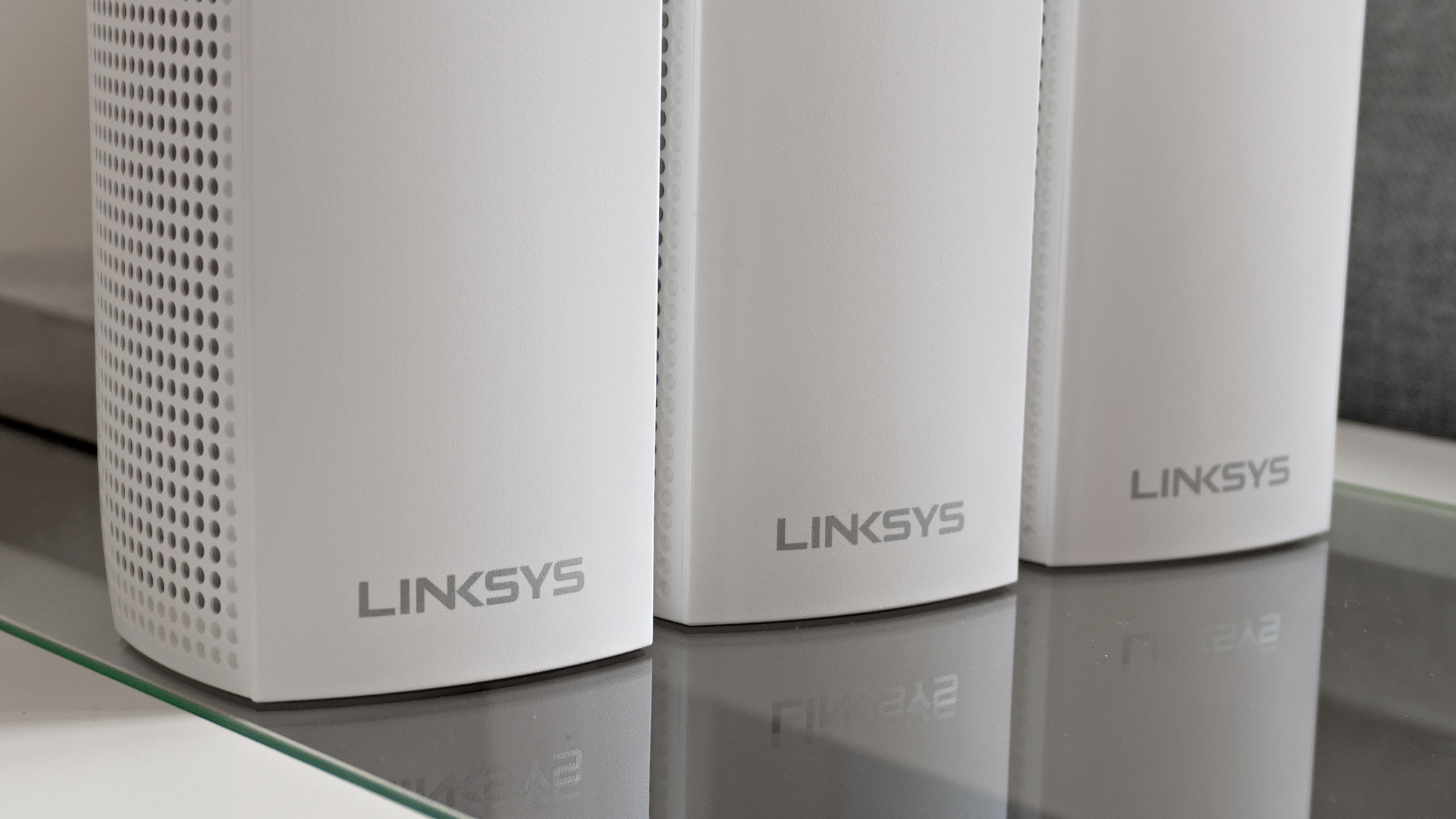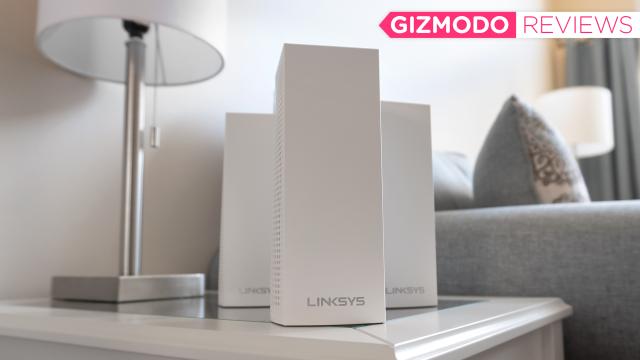In 2013, researchers at MIT demonstrated how the Wi-Fi signals that fill every corner of your home with high-speed internet could also be used to detect the movements of pets and people—even through walls. Six years later, Linksys has introduced similar functionality on its tri-band mesh routers, and while the technology is clearly still in its infancy, it provides an interesting look at how the smart home will evolve in the coming years.

Linksys Velop AC6600 Mesh Wifi System
WHAT IS IT
A mesh Wi-Fi system that can also use its wireless signals as a rudimentary motion detector for your home.
PRICE
$US230 ($334) each, $US350 ($508) for a two-pack, or $US530 ($769) for a three-pack, plus a $US2.99 ($4)/month or $US24.99 ($36)/year subscription
LIKE
Demonstrates a clever alternate use of Wi-Fi technology.
DISLIKE
Access points have limited range which can make placement tricky.
Editor’s Note: Australian pricing for the Linksys Velop AC6600 is currently unannounced.
Known as Linksys Aware, the new feature is slowly being rolled out on the company’s Velop tri-band AC2200 routers through firmware and smartphone app updates, and I tested it using the company’s Velop AC6600 mesh Wi-Fi system, which includes three nodes.
As hardware design goes, the Linksys Velop products are boring with a capital B—but that’s a good thing. Each one looks like a stark white obelisk standing about a foot tall with a design that says ‘don’t worry, I’m not going to attract any attention.’ One of the biggest benefits of a mesh Wi-Fi system is that you don’t need a clunky oversized router with antennas sticking out of every direction for excellent Wi-Fi coverage throughout your home. Multiple smaller nodes all work together to ensure reliable Wi-Fi reaches every last device.
Even the status LEDs on each node are minimal: a tiny multi-coloured dot on top that facilitates troubleshooting at a glance if you take the time to learn what each colour and flashing pattern means. As for the technical bits, those are hidden on the underside of each node with a power jack, a reset button, a physical power switch, and a pair of auto-sensing gigabit Ethernet ports. Unlike mesh Wi-Fi solutions from companies like Google, all three of the Linksys Velop nodes are exactly the same hardware which makes the setup process ever so slightly easier as it doesn’t matter which one gets placed where.
I’ll also note that while this is a tri-band system with two 5GHz bands and a single 2.4GHz band, the Linksys Velop system doesn’t have a dedicated wireless backhaul channel to handle communications between the nodes. The software automatically chooses which of the three bands to use based on network traffic, but a dedicated backhaul channel can be created using ethernet cables if that’s vitally important to you.
Most wireless mesh systems are now set up and configured using mobile apps, and Linksys’ app makes the process relatively painless—although there are times where you’ll find yourself staring at a progress bar that takes five or six minutes to slowly creep across the screen. But my biggest complaint, and this is something I’ve experienced before when setting up Linksys Velop systems for family members, is the limited distance you can place nodes from each other.
After connecting one of the nodes to the cable modem in my family room, I tried to place a node, with a nearly unobstructed view, about 40 feet away in my living room. But the app indicated the signal between the two nodes wasn’t great at that distance, and suggested I should move it closer. Unfortunately, precisely positioning the nodes is a trial and error process that could potentially add quite a bit of time as you might need to keep running test after test to ensure all the nodes are well connected. That being said, with the three nodes I successfully set up in my home—two on the main floor and one upstairs—I had rock-solid Wi-Fi coverage throughout my entire house, including the basement.
As far as features go the Linksys Velop mesh Wi-Fi system has just about everything the average consumer could need, including internet speed tests built right into the app, the ability to set up a guest network, parental controls, a detailed breakdown of all the devices connected to the wireless network, and the option to prioritise up to three of those devices to ensure that, for example, a media player will have enough bandwidth to handle a 4K stream, or that online gaming on a console experiences minimal slowdowns.
What sets Linksys’ tri-band Velop system apart from the competition right now is the aforementioned Linksys Aware feature. Taking advantage of the fact that the nodes are constantly beaming radio waves back and forth between each other (a minimum of two nodes are required for the feature to work) Linksys Aware can detect the changes in intensity of those waves over time as they’re partially and intermittently obstructed by the presence of an object moving through the network’s coverage area.
It’s an incredibly clever trick, and in the Linksys mobile app you can actually see the wireless network detecting movement in real-time on a simple scrolling graph. The highest peaks represent whenever I was walking around, while the shorter ones reveal times when I tried to stand perfectly still, but my subtle movements were still recognised. The graph only fell nearly completely flat once I left the house entirely.
But it’s also a feature that comes with quite a few caveats. You can turn on notifications for when motions are detected, but you’ll want to also immediately set up a schedule so the app only harasses you when there’s (supposed to be) nobody home. You’ll also need to fine-tune the Linksys Aware’s sensitivity settings, which can alert you to the movements of something as small as a mouse, or strictly objects as large as a human being. What the feature can’t do, at least yet, is tell you where in the house the motion has been detected, which floor it happened on, or even which node it was closest to. And because it works through walls, if you live somewhere with neighbours on the other side of a wall who can see your wireless network, there’s the chance that Linksys Aware will detect motions happening next door as well.
The technology is fascinating, and given it only took roughly six years to go from the lab to a consumer-ready product, there’s the potential for Linksys Aware to radically change the smart home of the future. It could potentially eliminate motion sensors, improve security, keep a watch on everyone in a home, and even improve the performance of a wireless network. If you’re on the hunt for a Wi-Fi mesh system it could be a solid reason to go with Linksys’ Velop hardware as the feature will undoubtedly be improved and enhanced over time through software updates.
But is it a reason to switch over to Linksys right now? I don’t think so. The motion detection is rudimentary at best. Most home security systems (although often requiring a complicated installation) will at least tell you where motion has been detected in your home, which I’ve found to be a must-have feature. And if you’ve already got Linksys Velop hardware at home that’s eligible for the Linksys Aware upgrades, I’m not even sure if the required $US3 ($4)/month or $US25 ($36)/year subscription fee for the feature is worth it at this point. I would maybe hold off and keep an eye on how this technology develops and evolves, because eventually I do think it’s going to be a game-changer.
README
-
A solid mesh networking solution that’s priced comparatively to products like Google Nest Wifi, but still includes gigabit ethernet ports on each node.
-
Watching a wireless network detect motions, even subtle movements, with no additional hardware is a fascinating use of Wi-Fi technology and a potential game-changer for smart homes. But the technology is currently very limited, and not quite yet a must-have feature.
-
Instead of a dedicated backhaul channel the Linksys Velop system automatically chooses which of its three bands the nodes should communicate on for the best performance. Although a dedicated backhaul channel can be set up using ethernet cables.
-
Using Linksys Aware requires a $US3 ($4)/month or $US25 ($36)/year subscription which is a little pricey given this technology’s current limitations.
-
The setup process using the mobile app is easy to follow, but can be time-consuming as the placement of the nodes to ensure they have a strong signal requires some trial and error testing, and their overall connectivity range seems to be limited.
